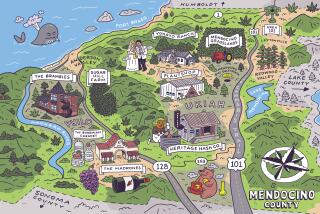Weed culture. True crime. Bigfoot lore. ‘Sasquatch’ has something for everyone
- Share via
True crime, weed wars and monster tales meet in “Sasquatch,” and Hulu’s three-part docuseries delivers on all fronts.
This hybrid whodunit/monster-hunter mashup, premiering Tuesday, is centered around one central unsolved mystery, and several ancillary riddles, in the Emerald Triangle, a swath of Northern California wilderness across Mendocino, Humboldt and Trinity counties. It’s renowned for its natural beauty, marijuana production — and Bigfoot sightings.
Leading us into the tangled woods is investigative reporter David Holthouse, who was working on a Mendocino dope farm in 1993 when a group of terrified men burst into his cabin with claims of finding three mutilated bodies at a nearby farm. The deceased were torn limb from limb, heads ripped from torsos, their parts strewn around the campsite. This wasn’t a drug heist, they said. No marijuana plants were stolen — and there were giant footprints around the scene. It had to be Bigfoot.
Or did it?
Netflix’s four-part docuseries “Night Stalker: The Hunt for a Serial Killer” deftly captures a time and place that many Angelenos will never forget.
“Sasquatch” sets out to answer that question over three brisk, gripping and occasionally creepy hours. Holthouse is a compelling character. He‘s an unconventional gumshoe reporter, with long hair and Western-tailored shirts. He’s haunted by his past, which includes being sexually molested as a child, and has turned his internal battles outward: He’s written and spoken extensively about his experience and, in ensuing work, risked his own safety to expose other societal dangers by going undercover to report on skinheads and street gangs. But most important, he comes off as grounded, smart and totally credible — critical for a production titled “Sasquatch.”
“It sounds ridiculous on the face of it: A Bigfoot murdered three guys on a dope farm,” he says in the series. “But once you peel back the first layer of that and get [a] glimpse of the truth behind that crazy story it’s hard not to keep peeling back the layers…”
The narrative unfurls largely through his search and the strength of his interviews with the folks he tracks down with connections to the 1993 incident. What he finds exposes a “viper’s nest” of treacherous actors among the rustic cabins and fortified compounds of Mendocino’s marijuana industry.
The cast of characters interviewed includes Hell’s Angels, “Back to the Landers,” “squatchers,” tweakers, and guys with names like Bobo. Old-timers describe some of their meth-addicted, shut-in neighbors as “feral.” Cops, private investigators and former drug enforcement agents explain how difficult it is to police the isolated sites in such rugged terrain, and lawlessness now abounds.
On Thanksgiving eve 1971, mystery hijacker D.B. Cooper parachuted into the night with $200,000. Our enduring obsession with the case says a lot about America, then and now.
Bigfoot aficionados come out in force here too, explaining what they know about the creature and its habits. Most feel it would be highly unusual for a “squatch” to attack and kill a human. If anything, it would protect us, says Bob Gimlin, one half of the team who shot the infamous 1967 Patterson–Gimlin film, now considered the “gold standard” of Bigfoot footage. But it’s understandable if it did get aggressive, says another tracker, since the dope growers keep pushing farther and farther into its territory.
The Duplass brothers production, directed by Joshua Rofé, chronicles the evolution of the region from a hippie utopia where families homesteaded and grew weed as a means to support their families in the 1970s to a high-stakes, paranoid crime syndicate of booby-trapped compounds where the missing-person count is higher per capita than anywhere in the nation.
High on that MIA list are the undocumented workers who flock to the area to work the harvests. Their stories illuminate an unfortunate but predictable anti-immigrant sentiment that seems pervasive across the U.S.
So who killed the men in that 1993 story? Were they killed at all? No way I’m going to spoil this crazy ride through wildly entertaining, untamed terrain. It’s a tale worth hearing firsthand.
More to Read
The complete guide to home viewing
Get Screen Gab for everything about the TV shows and streaming movies everyone’s talking about.
You may occasionally receive promotional content from the Los Angeles Times.







